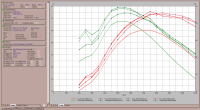DirtyErnie
Renaissance Hick
"Working From Home" has left me alone in a small room with my computer for more hours than I should be, and with a wife and kid running around the house.... let's just say looking at skinny girls is right out.
So I dusted off a Windows98 virtual machine and an old copy of Dyno 2000 and started putting in motorcycle numbers for grins. When I geek on something, I like to share it with the class.
Small-Tube vs Large-tube headers are similar to how the intakes work, just adding/subtracting torque in whatever RPM range they're programmed to.
Pretty sure both of those have good effect on the numbers because of how high the valve/cylinder volume ratio is.
I'll do some MegaCycle stuff later, and maybe get some screen-grabs from the calcs over at Wallace Racing.
So I dusted off a Windows98 virtual machine and an old copy of Dyno 2000 and started putting in motorcycle numbers for grins. When I geek on something, I like to share it with the class.
- Airflow data is from the 'D-Port Head' thread, as a 'best case scenario' for ported XS650 flow, and reliable 'stock' airflow.
- --Honestly, this engine has waaay more airflow and waaaay more valve than it needs for 327.5cc/cylinder. At some point, I might grab pics of what the calculators over at Wallace Racing say about this engine. Cliff's Notes: stock head should push 115+Hp @ 12Krpm, ported 125 @ 13K.Maybe the calcs are a bit basic, but after playing around with D2K for a month, the heads could do it. Valve springs and crankshaft are a different story. Stock intake cross-section is about perfect for 750cc+ at 7,500RPM.
- Cam data is from various vendors and threads on here, stock info from the manual.
- Carb airflow is kinda based on some forum crawling, kinda based on some hunches, and kinda based on the curves looking like they have 'enough'. Stock carbs weren't really ever a big restriction so long as the stock mufflers were on.
Small-Tube vs Large-tube headers are similar to how the intakes work, just adding/subtracting torque in whatever RPM range they're programmed to.
Pretty sure both of those have good effect on the numbers because of how high the valve/cylinder volume ratio is.
- Remember, This thing is trying to find crankshaft horsepower, which we have no way of obtaining on these bikes.
- - There's a spur gear driving the clutch, a transmission, and then a chain drive before the back tire hits the dyno. Not a real efficient driveline, all things considered.
- Don't get hung up on the numbers, remember: we're comparing cam vs cam. Pay attention to the curves.
- Stock~ish. I don't really know carb airflow to any great degree, and the 'Small-Tube Headers with Mufflers option, which eats like 5hp up top. 51ft/lb @ 5,000-6,000, 60hp @ 7-7.5K
- Stock cam, Ported heads, bigger, open headers. The stock cam doesn't exactly suck in an engine that breathes. 56ft/lb @ 5.5-6K, 74hp @ 8-9K (marked with diamonds on the graph.)
- Shell #1, ported heads, big, open headers. More torque everywhere, some squiggles below 3k, which I assume means the simulator thinks the engine might not like it. meh. 59ft/lb @ 5-5.5K, 76hp @ 7.5K (marked with squares on the graph)
- Shell #1 Mis-grind I bought from Hoos ca. 2011. Gary said this batch got ground with the exhaust 5° early, so this curve may only be of interest to me. Seems a little 'peakier' than the real-deal Shell, at least in the virtual world. In the real world, I love my bike. 59ft/lb @ 5.5k, 74hp @ 7.5K (marked with triangles on the graph)
I'll do some MegaCycle stuff later, and maybe get some screen-grabs from the calcs over at Wallace Racing.
Attachments
Last edited:

